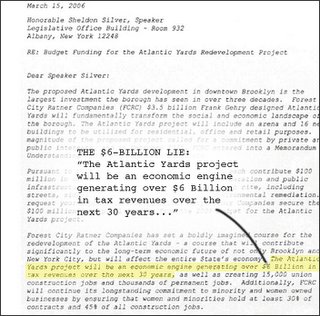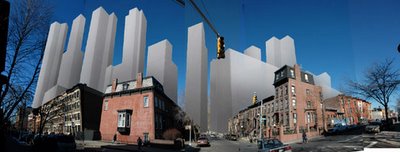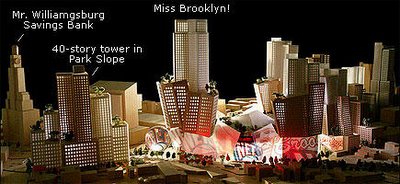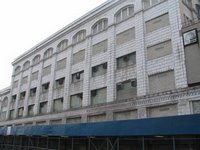 Yesterday Forest City Ratner (FCR) debuted a new web site for the Atlantic Yards project, some six months after its outdated Bball.net site was placed "under construction." While it offers more information, including official documents, than the static predecessor site (access via the Internet Archive), AtlanticYards.com includes enough distortions, omissions, and lies to provide a highly deceptive picture of the project.
Yesterday Forest City Ratner (FCR) debuted a new web site for the Atlantic Yards project, some six months after its outdated Bball.net site was placed "under construction." While it offers more information, including official documents, than the static predecessor site (access via the Internet Archive), AtlanticYards.com includes enough distortions, omissions, and lies to provide a highly deceptive picture of the project. Though the "Jobs, Housing, and Hoops" slogan seems to have been put aside, the site repeats the deeply dishonest claim that the project would bring $6 billion in revenues to the city and state; it promises that the project would create 18,000 jobs (though the number of people getting those jobs might be one-sixth that number); and it touts 50% of the project's rental units as affordable, even though in 2004--before the developer added thousands of market-rate condos--FCR promised that half of the entire residential project would be affordable. (So did Borough President Marty Markowitz, right, at a rally for the project in 2004.)
Though the "Jobs, Housing, and Hoops" slogan seems to have been put aside, the site repeats the deeply dishonest claim that the project would bring $6 billion in revenues to the city and state; it promises that the project would create 18,000 jobs (though the number of people getting those jobs might be one-sixth that number); and it touts 50% of the project's rental units as affordable, even though in 2004--before the developer added thousands of market-rate condos--FCR promised that half of the entire residential project would be affordable. (So did Borough President Marty Markowitz, right, at a rally for the project in 2004.)The photos chosen (see slideshow, but I was unable to get screen grabs) exaggerate the level of blight on the site footprint--the only interior photos, for example, are of structures that deteriorated (partly under FCR's watch) and are slated for demolition. Even though Assemblyman Roger Green, a project proponent, says the neighborhood isn't blighted, blight will be the justification for the use of eminent domain for those homeowners and business owners who do not wish to sell to Ratner.
 It's been two years and four months since the project was announced, but we still don't know what the buildings will look like. The site touts starchitect Frank Gehry, but the only designs we see from him are some arena interior shots and a sketch (right) of overhead views of the arena and the surrounding towers. (Quick: what's a premium entry? And where's the "urban room" that has been repositioned to do double duty as arena box office and civic space?)
It's been two years and four months since the project was announced, but we still don't know what the buildings will look like. The site touts starchitect Frank Gehry, but the only designs we see from him are some arena interior shots and a sketch (right) of overhead views of the arena and the surrounding towers. (Quick: what's a premium entry? And where's the "urban room" that has been repositioned to do double duty as arena box office and civic space?)The Downtown dodge
 The site begins with a dodge: Welcome to Atlantic Yards, the development dedicated to building a new vision for downtown Brooklyn. As I've pointed out, it's in the company's interest to misleadingly locate the project in Downtown Brooklyn rather than a mostly low-rise neighborhood like Prospect Heights. (Photos below from Develop Don't Destroy Brooklyn.)
The site begins with a dodge: Welcome to Atlantic Yards, the development dedicated to building a new vision for downtown Brooklyn. As I've pointed out, it's in the company's interest to misleadingly locate the project in Downtown Brooklyn rather than a mostly low-rise neighborhood like Prospect Heights. (Photos below from Develop Don't Destroy Brooklyn.) The New York Times Metro section now calls the location "near Downtown Brooklyn." FCR touts the Downtown Brooklyn rezoning (which does not encompass the Atlantic Yards footprint) as justification for the density sought in the new development, in which the Empire State Development Corporation will override current zoning.
The New York Times Metro section now calls the location "near Downtown Brooklyn." FCR touts the Downtown Brooklyn rezoning (which does not encompass the Atlantic Yards footprint) as justification for the density sought in the new development, in which the Empire State Development Corporation will override current zoning.Adding up the benefits
 A section on the benefits of the project offers this unsupported claim: "As renowned sports economist Andrew Zimbalist has noted, Atlantic Yards will be an economic engine for Brooklyn, the City and the State, generating more than $6 billion in tax revenues over the next 30 years."
A section on the benefits of the project offers this unsupported claim: "As renowned sports economist Andrew Zimbalist has noted, Atlantic Yards will be an economic engine for Brooklyn, the City and the State, generating more than $6 billion in tax revenues over the next 30 years." Besides the $6 billion lie, which I discuss below, AtlanticYards.com claims that there will be "Over 18,000 jobs created." The verb create suggests 1) that the jobs will not previously exist and that 18,000 people who lack jobs will be put to work. However, the 15,000 construction jobs promised represent 1500 jobs a year for ten years, as construction jobs are calculated in job-years.
Besides the $6 billion lie, which I discuss below, AtlanticYards.com claims that there will be "Over 18,000 jobs created." The verb create suggests 1) that the jobs will not previously exist and that 18,000 people who lack jobs will be put to work. However, the 15,000 construction jobs promised represent 1500 jobs a year for ten years, as construction jobs are calculated in job-years. Also note that only a fraction of the 2500 office jobs now promised would be new as opposed to moved from Manhattan; the New York City Economic Development Corporation estimated (see p. 6) that only 30 percent of office jobs would be new. FCR originally was more candid; the office jobs were billed as "over 10,000 permanent jobs created and/or retained in the commercial offices." (Emphasis added)
The web site also promises 770 retail jobs, 70 hotel jobs, and 400 jobs in the Brooklyn Arena. However, as the New York Observer reported in November, those arena jobs are subject to union rules and may be filled with current employees.
So let's recap:
--1500 construction jobs
--770 retail jobs
--70 hotel jobs
--750 new office jobs (30 percent of 2500).
Total: 3090 new jobs, not 18,000 jobs.
Housing
A page on housing announces that the developer has "agreed to build between 600 and 1,000 affordable units on or off-site for sale to low- and middle-income first time homeowners" but there's no mention of that in the documents produced by the Empire State Development Corporation.
As for the affordable rentals, little more than 900 of the 2250 units would be available to families earning under $35,000, the Brooklyn median income. Affordability is calculated based on area median income (AMI), which includes wealthy suburbs.
Missing documents
A page on the site titled Related documents offers several relevant documents, including the Empire State Development Corporation's Draft Scope of Analysis and Final Scope, the prelude to the Draft Environmental Impact Statement expected within two months. The page also links to the Community Benefits Agreement signed with eight groups, and the Independent Budget Office's analysis of the arena component of the project.
 The page links to the 2005 report FCR commissioned from sports economist Andrew Zimbalist, who estimated that the project would bring $6 billion in revenues to the city and state over 30 years--a statistic the developer has touted in its lobbying letter (right) to state legislators regarding $100 million in subsidies. I've detailed why the claim is deeply deceptive: it overstates revenues, ignores and then lowballs costs (nothing for traffic or police), and manipulates statistics to exaggerate revenues. Other estimates on the project calculate the revenues and costs in terms of present value, or current dollars, rather than a 30-year total. FCR's claim is like saying a $200,000 mortgage is worth $600,000 because that's the total of the payments over 30 years.
The page links to the 2005 report FCR commissioned from sports economist Andrew Zimbalist, who estimated that the project would bring $6 billion in revenues to the city and state over 30 years--a statistic the developer has touted in its lobbying letter (right) to state legislators regarding $100 million in subsidies. I've detailed why the claim is deeply deceptive: it overstates revenues, ignores and then lowballs costs (nothing for traffic or police), and manipulates statistics to exaggerate revenues. Other estimates on the project calculate the revenues and costs in terms of present value, or current dollars, rather than a 30-year total. FCR's claim is like saying a $200,000 mortgage is worth $600,000 because that's the total of the payments over 30 years.The new web site, however, does not link to Zimbalist's 2004 report on the project. Yes, it's outdated (but so is his 2005 report, because the project has changed), but what's striking is how Zimbalist's revenue estimate leaped by $2 billion in one year based mainly on new income taxes paid by new residents of the luxury housing added by FCR. Nice trick--but if legitimate, every luxury housing project would be an economic engine rather than a spur to reforming subsidy programs.
James Parrott of the Fiscal Policy Institute told me, "I don't know of any serious cost-benefit analyses of mixed-used economic development projects that count the taxes of residents."
The page also lacks links to reports from the New York City Economic Development Corporation and the Pratt Institute Center for Community and Environmental Development, both of which challenge Zimbalist's estimates.
By the way, the link to Zimbalist's report describes him as an "independent expert" rather than an academic who was paid by the developer to produce a document, who used statistics supplied by the developer, and refused to provide citations to independent critics.
Which press releases?
 The pressroom section also contains a selective list of press releases, including ones concerning the revised Atlantic Yards scale (which falsely claims that the project has been reduced from its original), demolition of buildings in the Atlantic Yards footprint, and Forest City Ratner philanthropy (but not including the Robinson/Reese statue).
The pressroom section also contains a selective list of press releases, including ones concerning the revised Atlantic Yards scale (which falsely claims that the project has been reduced from its original), demolition of buildings in the Atlantic Yards footprint, and Forest City Ratner philanthropy (but not including the Robinson/Reese statue). The press releases go back only as far as 9/16/05, so we don't see the original promises regarding the project (which would indicate that the project has grown, not shrunk since the original announcement and remind people that the company once promised 10,000 office jobs rather than one-quarter that number).
It doesn't include the press release from last June announcing the Brooklyn Standard "publication." The Brooklyn Standard is not linked from this site; FCR has mounted only the first issue, not the controversial second issue, where a freelancer's byline was placed on stories he didn't write.
In the News?
A page titled In the News links to recent articles about state funding for the project as well as links to several articles about FCR's slight reductions in the scale. Absent: the Brooklyn Papers's more skeptical Bruce reamed over Yards ‘concession’.
There's also a link to the 4/10/06 New York Times article I critiqued about some former residents who, thanks to FCR's one-time lifting of a gag order, were allowed to talk about how FCR mostly treated them nicely in efforts to relocate. AtlanticYards.com describes it: The New York Times takes a look at some of the people who live, or used to live, in the development's footprint and what the developer, Forest City Ratner Companies (FCRC), is doing to help ease the transition.
The CBA and beyond
 A page on the Community Benefits Agreement cites the eight groups (by the way, the First Atlantic Terminal Housing Committee is now the Brooklyn Endeavor Experience, Inc.) that partnered with the developer. Unmentioned is that only two of the eight were incorporated at the time of signing the CBA, as the New York Observer reported. (In the photo (l.-r.), from AtlanticYards.com, Assemblyman Roger Green (second from left), James Caldwell of BUILD, Mayor Mike Bloomberg, Bertha Lewis of ACORN, the Rev. Herbert Daughtry, and FCR President Bruce Ratner.)
A page on the Community Benefits Agreement cites the eight groups (by the way, the First Atlantic Terminal Housing Committee is now the Brooklyn Endeavor Experience, Inc.) that partnered with the developer. Unmentioned is that only two of the eight were incorporated at the time of signing the CBA, as the New York Observer reported. (In the photo (l.-r.), from AtlanticYards.com, Assemblyman Roger Green (second from left), James Caldwell of BUILD, Mayor Mike Bloomberg, Bertha Lewis of ACORN, the Rev. Herbert Daughtry, and FCR President Bruce Ratner.) “This is the most far-reaching CBA in the country," declares ACORN's Lewis, who is contractually obligated to support the project. Unmentioned is that experts like Bettina Damiani of Good Jobs New York have described how more legitimate CBAs bring together groups that would ordinarily oppose a project, rather than the groups that signed this CBA.
The AtlanticYards.com site declares, "In addition, over 200 community leaders and organizations have affirmed their support for the landmark agreement." Last August, after the claim was released, the New York Observer "asked for the list and counted fewer than 175; and that's only if 'organizations' include elected officials, restaurants and real-estate agencies, as well as block associations and the like," not to mention groups from Queens and Manhattan.
The section for Related Sites further points to the limits of the CBA. It contains links to a longstanding group like ACORN and the much newer BUILD (Brooklyn United for Innovative Local Development), but not to any of the other six signatories to the CBA. There is, however, a link to the Rev. Herbert Daughtry's House of the Lord Church; Daughtry has formed a group, the Downtown Brooklyn Neighborhood Alliance, which is one of the signatories, and, like BUILD, has already been funded by FCR. Greg LeRoy, an expert on CBAs, told the Brooklyn Papers last September: “Anytime you have negotiations in which there are competing self-interests, and one side grants a favor to the other, that’s a red flag."
Open space
 FCR has hired noted landscape architect Laurie Olin to design the 7+ acres of open space, and the slideshow sure is pretty. But "renderings can make any space look great," observes architect Jonathan Cohn, who argues that closing streets and creating superblocks serves the developer more than the public. Nor does FCR acknowledge that the amount of open space would be far less than city guidelines recommend.
FCR has hired noted landscape architect Laurie Olin to design the 7+ acres of open space, and the slideshow sure is pretty. But "renderings can make any space look great," observes architect Jonathan Cohn, who argues that closing streets and creating superblocks serves the developer more than the public. Nor does FCR acknowledge that the amount of open space would be far less than city guidelines recommend.The page on open space does include a 12/11/03 quote from Herbert Muschamp, then the architecture critic for the New York Times: "The Garden of Eden grows in Brooklyn…Almost everything the well-equipped urban paradise must have... Brooklyn Atlantic Yards is the most important piece of urban design New York has seen since the Battery Park City master plan was produced…"
This time, unlike with a flier the company issued in May 2004, the developer quotes Muschamp by name rather than attributing it to the Times in general. (Note that Muschamp, in his rapturous assessment of the project, did not acknowledge--as is now the Times's general practice--that the New York Times Company and FCR are business partners in building the new Times Tower. Also, Muschamp did not acknowledge that, along with FCR executives, he sat on the committee that chose the architect for the Times Tower. See Chapter 14 of my report.)
Stale quotes, staged rally
Despite the decline in jobs and increase in market-rate housing, the site repeats a quote from Senator Charles Schumer (from 2003 or 2004) boosting the previous iteration of the development: "It’s more than just basketball. It’s a dream, it’s jobs and it’s housing.”
 Another quote comes from a Daily News editorial: "Having a pro sports team relocate to Brooklyn would become a vivid emblem of the borough’s renaissance while producing that most elusive treasure, jobs.” Unmentioned is that the editorial was published on 1/25/04, when the developer was promising 10,000 office jobs, not one-quarter that number.
Another quote comes from a Daily News editorial: "Having a pro sports team relocate to Brooklyn would become a vivid emblem of the borough’s renaissance while producing that most elusive treasure, jobs.” Unmentioned is that the editorial was published on 1/25/04, when the developer was promising 10,000 office jobs, not one-quarter that number.Finally, a caption on a photo states: "Over 1,500 supporters rally to bring the Nets to Brooklyn at Brooklyn Borough Hall." While they were indeed supporters, that doesn't prove that support is widespread. According to the Brooklyn Papers, many of the supporters were organized by the District Council of Carpenters, ACORN, and BUILD--which stand to benefit from the project.
Missing politicians?
A page on supporters states:
The Atlantic Yards development is supported by a wide range of elected officials, unions, community leaders, issue advocates, urban development experts, religious leaders and organizations, local businesses and thousands of fans all across Brooklyn and the New York area.
These supporters include Governor Pataki, Mayor Bloomberg, U.S. Senator Charles Schumer, Congressman Edolphus Towns, Congressman Gregory W. Meeks, Congressman Anthony Weiner, Public Advocate Betsy Gotbaum, Comptroller William C. Thompson, Jr. and Brooklyn Borough President Marty Markowitz to name just a few.
The list is selective, but it would be interesting to see a list of all the "urban development experts" that support this project. (Is an expert an advocate for development like the Partnership for NYC? ) Where's Roger Green, who represents the area as an Assemblyman and was a major force behind the CBA? And didn't Gotbaum say she wouldn't support the project if it included eminent domain?
Answering questions?
 A secction on FAQs explains that "Miss Brooklyn," the 620-foot tower proposed for the corner of Flatbush and Atlantic Avenues, will be near the 512-foot Williamsburgh Savings Bank. It doesn't explain how the bank building is rather narrow--stepped back significantly after about halfway up.
A secction on FAQs explains that "Miss Brooklyn," the 620-foot tower proposed for the corner of Flatbush and Atlantic Avenues, will be near the 512-foot Williamsburgh Savings Bank. It doesn't explain how the bank building is rather narrow--stepped back significantly after about halfway up. The FAQ contends that "[t]he buildings are spaced and sized to minimize bulk," with heights stepped down along Dean Street and Vanderbilt Avenue and the taller buildings located near the commercial corridor of Flatbush and Atlantic Avenues. But we still haven't seen any designs, so for now we'll have to go with the rough renderings of the scale (above) by Will James of OnNYTurf.
The FAQ contends that "[t]he buildings are spaced and sized to minimize bulk," with heights stepped down along Dean Street and Vanderbilt Avenue and the taller buildings located near the commercial corridor of Flatbush and Atlantic Avenues. But we still haven't seen any designs, so for now we'll have to go with the rough renderings of the scale (above) by Will James of OnNYTurf.FCR states that the company "now owns or controls 90 percent of the land needed for Atlantic Yards" and that "assistance will be provided to any residential tenants who may be displaced by the development." Unmentioned is that assistance is limited, with some tenants offered rent differentials for only three years, which might be long before they could move into the new development.
 Here's the conclusory sequence on traffic (at right, Frank Gehry's former design, unveiled in the New York Times 7/5/05, and annotated by NoLandGrab.org):
Here's the conclusory sequence on traffic (at right, Frank Gehry's former design, unveiled in the New York Times 7/5/05, and annotated by NoLandGrab.org):Q: Will the new buildings and the arena bring in more traffic than the area can handle?
A: No. Atlantic Yards will be located directly over the City's third largest subway hub with 10 subway lines and the LIRR which will accommodate visitors and residents of Atlantic Yards. FCRC is looking at a number of programs and strategies to increase the usage of mass transportation. While recognizing the potential for traffic congestion at various intersections during certain peak hours of the day, FCRC is committed to working with city and state agencies and traffic experts, such as “Gridlock” Sam Schwartz to implement any mitigation measures that may be necessary. The public environmental review process will also include thorough traffic analyses to study and minimize traffic disruptions during all stages of construction and upon completion of the development.
Unmentioned are the comments by transportation engineer Brian Ketcham, who observed last year, "The main entry points to Brooklyn are all at overcapacity." Ketcham added, "We are heading into a disaster. I think we need to pull back and put this thing on hold for a year."
Underutilized buildings?
 In the slide show FCR refers to "underutilized or vacant industrial/manufacturing buildings" such as the Ward Bakery Building at 800 Pacific Street (right; photo not from AY site). In 2004, FCR agreed to pay owner Leviev Boymelgreen $44 million for the closed bakery and another property; the Brooklyn Papers had reported that the previous owner had planned to build a hotel. The Municipal Art Society considers the building a potential historic resource. In other words, there was and remains a market for this building; it is underutilized by design.
In the slide show FCR refers to "underutilized or vacant industrial/manufacturing buildings" such as the Ward Bakery Building at 800 Pacific Street (right; photo not from AY site). In 2004, FCR agreed to pay owner Leviev Boymelgreen $44 million for the closed bakery and another property; the Brooklyn Papers had reported that the previous owner had planned to build a hotel. The Municipal Art Society considers the building a potential historic resource. In other words, there was and remains a market for this building; it is underutilized by design.Two other former factory/warehouse buildings in the project footprint, 636 Pacific Street and 24 Sixth Avenue, were turned into housing, as was the former Daily News printing plant, now the Newswalk Building, on the block between Pacific and Dean streets that was cut out of the project (see plan diagram above).
There are indeed vacant and underutilized buildings, but some would be more active absent FCR's project. As Dean Street resident Peter Krashes told WNYC's Andrea Bernstein last December: This is inside the footprint, right, a lot of the property has the appearance of being more dormant. That’s one of the things that people miss when they walk here they don’t understand that what was a pretty active area has been emptied.
Where's the parking lot?
Another example of an underutilized space might be the interim surface parking lot FCR plans for the eastern portion of the site. The AtlanticYards.com FAQ section explains that public money would help fund infrastructure improvements like "public parking garages," but I couldn't find any mention of that parking lot.
Comments
Post a Comment